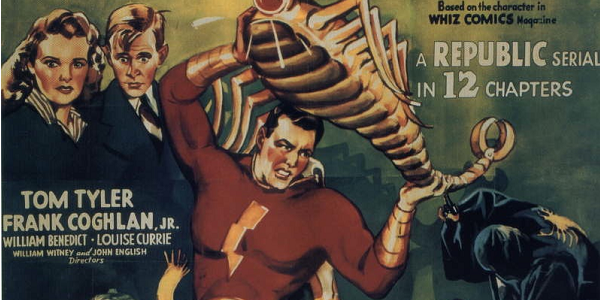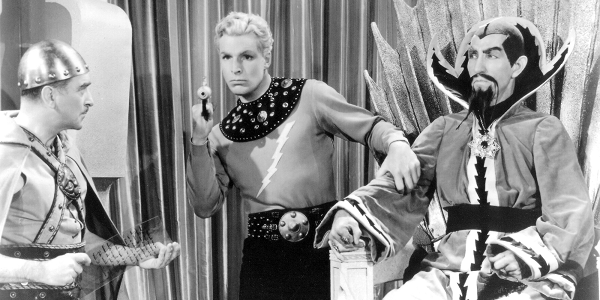6. The Cliffhanger Age - 1936-1965

ParamountBy the mid-1930s what would become known as the Golden Age of Comics was underway and film studios started to look towards comics for sources to adapt alongside the radio dramas and pulp novels that had already proved fertile material. Comics did not have enough prestige or clout to attract mainstream A-picture adaptations, but their family friendly, episodic, cliffhanger based narratives leant themselves perfectly to serials and, later, TV. The first comic movies drew on the more established tradition of newspaper comic strips than the relative novelty of book style comics and superheroes. Square jawed space adventurers exploring the low-cost wonders of the universe proved a popular genre with 1936's Flash Gordon followed by Buck Rogers in 1939. Meanwhile more cartoonish takes on the hardboiled noir crime story resulted in The Shadow (played on radio by Orson Welles) moving like Fantomas from pulp novels to comics. In 1937 the character made the move to film with The Shadow Strikes, which was swiftly followed by a 15 part serial for his comic strip equivalent, detective Dick Tracy, in what was the longest, most expensive Republic serial to date. This serial, which was successful enough to be re-edited together into a feature film and spawn three sequels, saw Tracy thwarting the grandiose schemes of crime boss The Spider and his henchman Dr. Moloch. This sort of rogues' gallery of larger than life mobsters and mad scientists was just as influential as the new superhero genre on the arrival of Batman on the page in 1939. While not an officially licenced Batman adaptation the first superhero film serial, Republic's "original" story The Mysterious Dr Satan, had its eponymous villain defeated by orphan Bob Wayne in the guise of a masked and cowled vigilante. Superman had made his debut on the page in 1938 and his instant popularity had Republic earmarking him as the first superhero to make the leap onto the screen (before they instead went with Dr Satan). After disputes with Superman's publisher National Periodical Publications (now DC Comics), Republic simply transplanted their planned serial onto a very similar character from Fawcett Comics. So it was The Adventures of Captain Marvel became the first onscreen take on a comic book superhero in 1941. National would have the last laugh, though, when their legal action over the derivative nature of Captain Marvel shut Fawcett down for good. Superman would appear in a series of Oscar nominated short animations from Fleischer Studios between 1941 and 43 in which the Man of Steel was voiced by radio Superman Bud Collyer. Kirk Alyn would don the tights when the Superman serial was finally made in 1948, but by then the age of the film serial was beginning to decline, while TV was about to prove its logical successor in cliffhanger storytelling. The Adventures of Superman first appeared on TV screens in 1952, broadcast nationwide on ABC. B-movie beefcake George Reeves took on the lead role for the movie-cum-pilot Superman and the Mole Men and over a hundred subsequent episodes before his violent death in the summer of 1959. The final 50 episodes were filmed in colour but broadcast monochrome. It was not until syndication in 1965 that Supes' fans would see their idol in patriotic red and blue. By then, though, Reeves' earnest heroics no longer resonated with a more counter cultural age.
Key Film: Flash Gordon (1936)

UniversalThe only comic adaptation selected for preservation by the US Library of Congress for being "culturally, historically or aesthetically significant", Universal's 1936 13 part story based on Alex Raymond's newspaper comic strip was the first comic-to-film translation and, as such, will always be an important and influential piece of film history. Flash paved the way and others followed (including his own sequel serials Flash Gordon's Trip to Mars and Flash Gordon Conquers the Universe).
 ParamountBy the mid-1930s what would become known as the Golden Age of Comics was underway and film studios started to look towards comics for sources to adapt alongside the radio dramas and pulp novels that had already proved fertile material. Comics did not have enough prestige or clout to attract mainstream A-picture adaptations, but their family friendly, episodic, cliffhanger based narratives leant themselves perfectly to serials and, later, TV. The first comic movies drew on the more established tradition of newspaper comic strips than the relative novelty of book style comics and superheroes. Square jawed space adventurers exploring the low-cost wonders of the universe proved a popular genre with 1936's Flash Gordon followed by Buck Rogers in 1939. Meanwhile more cartoonish takes on the hardboiled noir crime story resulted in The Shadow (played on radio by Orson Welles) moving like Fantomas from pulp novels to comics. In 1937 the character made the move to film with The Shadow Strikes, which was swiftly followed by a 15 part serial for his comic strip equivalent, detective Dick Tracy, in what was the longest, most expensive Republic serial to date. This serial, which was successful enough to be re-edited together into a feature film and spawn three sequels, saw Tracy thwarting the grandiose schemes of crime boss The Spider and his henchman Dr. Moloch. This sort of rogues' gallery of larger than life mobsters and mad scientists was just as influential as the new superhero genre on the arrival of Batman on the page in 1939. While not an officially licenced Batman adaptation the first superhero film serial, Republic's "original" story The Mysterious Dr Satan, had its eponymous villain defeated by orphan Bob Wayne in the guise of a masked and cowled vigilante. Superman had made his debut on the page in 1938 and his instant popularity had Republic earmarking him as the first superhero to make the leap onto the screen (before they instead went with Dr Satan). After disputes with Superman's publisher National Periodical Publications (now DC Comics), Republic simply transplanted their planned serial onto a very similar character from Fawcett Comics. So it was The Adventures of Captain Marvel became the first onscreen take on a comic book superhero in 1941. National would have the last laugh, though, when their legal action over the derivative nature of Captain Marvel shut Fawcett down for good. Superman would appear in a series of Oscar nominated short animations from Fleischer Studios between 1941 and 43 in which the Man of Steel was voiced by radio Superman Bud Collyer. Kirk Alyn would don the tights when the Superman serial was finally made in 1948, but by then the age of the film serial was beginning to decline, while TV was about to prove its logical successor in cliffhanger storytelling. The Adventures of Superman first appeared on TV screens in 1952, broadcast nationwide on ABC. B-movie beefcake George Reeves took on the lead role for the movie-cum-pilot Superman and the Mole Men and over a hundred subsequent episodes before his violent death in the summer of 1959. The final 50 episodes were filmed in colour but broadcast monochrome. It was not until syndication in 1965 that Supes' fans would see their idol in patriotic red and blue. By then, though, Reeves' earnest heroics no longer resonated with a more counter cultural age.
ParamountBy the mid-1930s what would become known as the Golden Age of Comics was underway and film studios started to look towards comics for sources to adapt alongside the radio dramas and pulp novels that had already proved fertile material. Comics did not have enough prestige or clout to attract mainstream A-picture adaptations, but their family friendly, episodic, cliffhanger based narratives leant themselves perfectly to serials and, later, TV. The first comic movies drew on the more established tradition of newspaper comic strips than the relative novelty of book style comics and superheroes. Square jawed space adventurers exploring the low-cost wonders of the universe proved a popular genre with 1936's Flash Gordon followed by Buck Rogers in 1939. Meanwhile more cartoonish takes on the hardboiled noir crime story resulted in The Shadow (played on radio by Orson Welles) moving like Fantomas from pulp novels to comics. In 1937 the character made the move to film with The Shadow Strikes, which was swiftly followed by a 15 part serial for his comic strip equivalent, detective Dick Tracy, in what was the longest, most expensive Republic serial to date. This serial, which was successful enough to be re-edited together into a feature film and spawn three sequels, saw Tracy thwarting the grandiose schemes of crime boss The Spider and his henchman Dr. Moloch. This sort of rogues' gallery of larger than life mobsters and mad scientists was just as influential as the new superhero genre on the arrival of Batman on the page in 1939. While not an officially licenced Batman adaptation the first superhero film serial, Republic's "original" story The Mysterious Dr Satan, had its eponymous villain defeated by orphan Bob Wayne in the guise of a masked and cowled vigilante. Superman had made his debut on the page in 1938 and his instant popularity had Republic earmarking him as the first superhero to make the leap onto the screen (before they instead went with Dr Satan). After disputes with Superman's publisher National Periodical Publications (now DC Comics), Republic simply transplanted their planned serial onto a very similar character from Fawcett Comics. So it was The Adventures of Captain Marvel became the first onscreen take on a comic book superhero in 1941. National would have the last laugh, though, when their legal action over the derivative nature of Captain Marvel shut Fawcett down for good. Superman would appear in a series of Oscar nominated short animations from Fleischer Studios between 1941 and 43 in which the Man of Steel was voiced by radio Superman Bud Collyer. Kirk Alyn would don the tights when the Superman serial was finally made in 1948, but by then the age of the film serial was beginning to decline, while TV was about to prove its logical successor in cliffhanger storytelling. The Adventures of Superman first appeared on TV screens in 1952, broadcast nationwide on ABC. B-movie beefcake George Reeves took on the lead role for the movie-cum-pilot Superman and the Mole Men and over a hundred subsequent episodes before his violent death in the summer of 1959. The final 50 episodes were filmed in colour but broadcast monochrome. It was not until syndication in 1965 that Supes' fans would see their idol in patriotic red and blue. By then, though, Reeves' earnest heroics no longer resonated with a more counter cultural age.  UniversalThe only comic adaptation selected for preservation by the US Library of Congress for being "culturally, historically or aesthetically significant", Universal's 1936 13 part story based on Alex Raymond's newspaper comic strip was the first comic-to-film translation and, as such, will always be an important and influential piece of film history. Flash paved the way and others followed (including his own sequel serials Flash Gordon's Trip to Mars and Flash Gordon Conquers the Universe).
UniversalThe only comic adaptation selected for preservation by the US Library of Congress for being "culturally, historically or aesthetically significant", Universal's 1936 13 part story based on Alex Raymond's newspaper comic strip was the first comic-to-film translation and, as such, will always be an important and influential piece of film history. Flash paved the way and others followed (including his own sequel serials Flash Gordon's Trip to Mars and Flash Gordon Conquers the Universe).